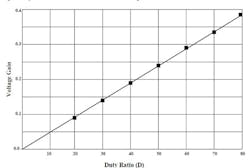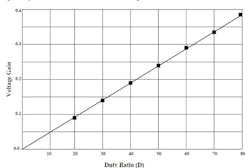Single 48V to 1V, 200A Converter Powers Microprocessors (Part 3) (.PDF Download)
The Hybrid Switching converter operates from either 48V or 12V input to generate 1V, 200A output. It eliminates switching losses of all three MOSFET devices and the transformer leakage inductance losses to achieve over 99% efficiency. It’s the only converter that handles large and fast load current transients in a fraction of a single switching cycle—with one module and only three MOSFET switches!
Obviously, the converter can be scaled up in current to 100A and 240W at 2.4V, as illustrated in Figure 11, provided the resistive losses are likewise reduced by use of appropriately scaled resistive losses of the components.
11. Linear voltage gain measurement.
Only two identical converters operated in parallel but shifted in time for exactly half a switching period (Fig. 12) are sufficient to reduced output ripple voltage to an ultra-low value despite using 20 times less capacitance then needed in a single synchronous buck converter. Figures 12 and 13 show the circuit and its timing diagram, respectively.

